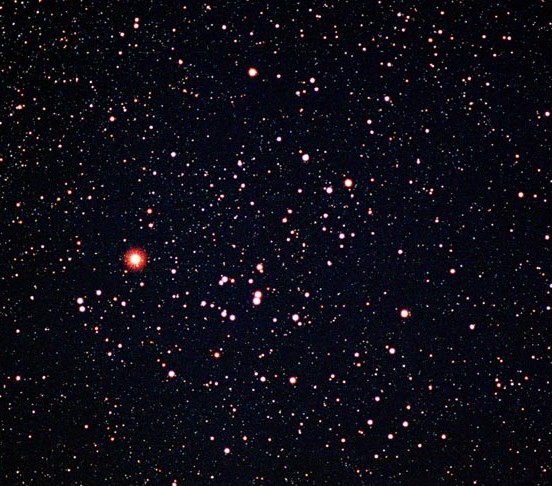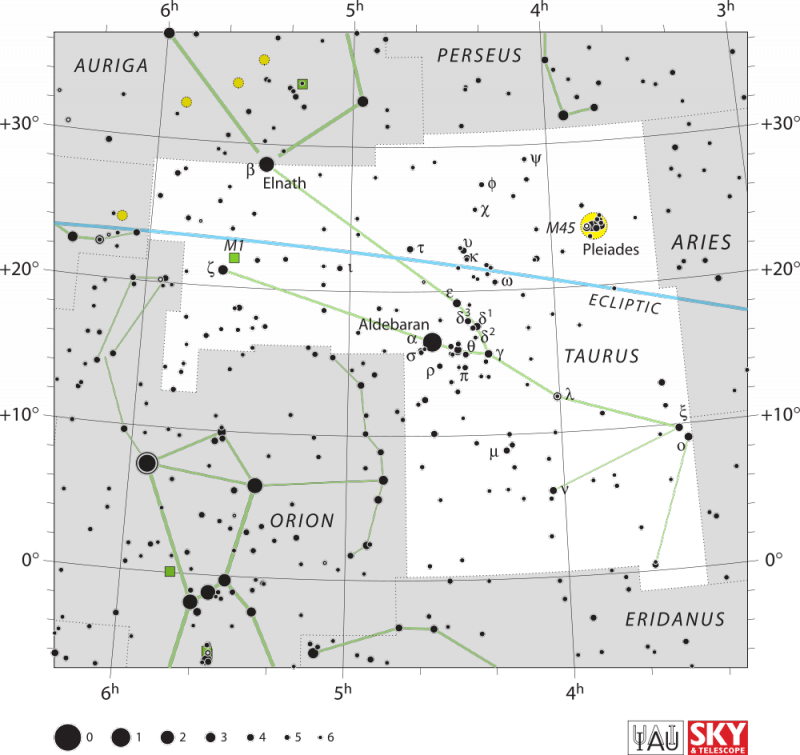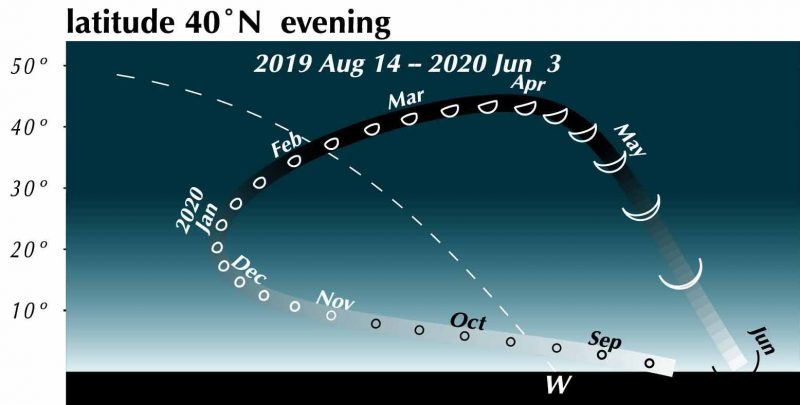
On March 1 and 2, 2020 – in the west, after sunset – the moon shines in front of the constellation Taurus the Bull. Taurus has two major signposts: the ruddy star Aldebaran, marking the Eye of the Bull, and the Pleiades star cluster, which is shaped like a tiny, misty dipper of stars. Also on these evenings, the moon’s lit side points directly at the dazzling planet Venus, which sits closer to the sunset horizon.
Given clear skies, you’ll have no trouble seeing the moon and Venus, which rank as the second-brightest and third-brightest celestial objects, respectively, after the sun. You’ll need a bit more darkness to see Aldebaran and the Pleiades on the great dome of the sky.
The Pleiades is an actual cluster of stars, sibling stars born from the same cloud of dust and gas.
Aldebaran, the brightest star in Taurus, sit atop another cluster of stars, a V-shaped assemblage that represents the Bull’s face. The stars in this V, with the exception of Aldebaran, are members of the cluster, which is called called the Hyades.
Because the Hyades is closer to us than the Pleiades, this beautiful cluster of stars appears more spread out than the compact Pleiades.

Can you make out the V in this pattern of stars? It’s easy to see the V with the eye alone, but this is a telescopic image. A telescope reveals over 100 stars in the Hyades cluster. The bright red star here is Aldebaran. Photo via astronomycafe.net.

The delightful Pleiades cluster as seen through a small telescope. Image via dr carl.

How can you be sure you’ve found Aldebaran? Orion’s Belt, at the lower left, always points in its direction. The star Aldebaran resides to the south of the ecliptic and the Pleiades star cluster to the north of the ecliptic, which is indicated by a blue line on this chart. Chart via IAU.
As darkness falls on March 2, 2020, the moon will be at or near its half-lit first quarter phase. Because the first quarter moon is 90 degrees east of the sun, the first quarter moon shows you where the sun will reside in front of Taurus some three months hence, or in early June 2020.
Click on Heavens-Above to know the moon’s present position in front of the constellations of the zodiac
Now let’s focus on Venus, which now shines in front of the constellation Pisces the Fish. This whole next month, watch for Venus to travel upward, toward the constellation Taurus. In the meantime, Taurus will be sinking closer to the setting sun day by day.
Venus will swing some 2.5 degrees north of the faint planet Uranus (in the constellation Aries) to stage a conjunction on March 9. However, you’ll probably need an optical aid to view Uranus, the seventh planet outward from the sun. On a dark night, people with good vision can see Uranus as a faint speck of light.
Click here for a sky chart of Uranus via Sky & Telescope
On March 24, 2020, Venus will reach its greatest elongation from the sun. After that, Venus will slowly fall sunward, but will remain an evening “star” for a few more months. Although Venus will be sinking downward relative to the setting sun, Venus will still be moving eastward relative to the backdrop stars of the zodiac. A little over month form now – April 3, 2020 – Venus will couple up with the Pleiades cluster, and by late April/early May 2020, Venus will be shining at its brightest best in the evening sky.
Venus will begin its retrograde (westward motion) in front of the background stars on May 13, 2020, and will transition out of the evening sky and into the morning sky in early June 2020.

View larger. | Chart by Guy Ottewell showing the changing phases of Venus in the evening sky via his blog. Venus first entered the evening sky (at full phase) in August 2019 and will leave the evening sky (at new phase) in early June 2020. In early March 2020, Venus’ disk is a bit more than 60 percent illuminated. By late March 2020, that’ll shrink to less than 50 percent.
Bottom line: On March 1 and 2, 2020, the waxing moon is near the bright red star Aldebaran in Taurus the Bull and the Pleiades star cluster. Dazzling Venus is nearby.
from EarthSky https://ift.tt/2TnlZCM

On March 1 and 2, 2020 – in the west, after sunset – the moon shines in front of the constellation Taurus the Bull. Taurus has two major signposts: the ruddy star Aldebaran, marking the Eye of the Bull, and the Pleiades star cluster, which is shaped like a tiny, misty dipper of stars. Also on these evenings, the moon’s lit side points directly at the dazzling planet Venus, which sits closer to the sunset horizon.
Given clear skies, you’ll have no trouble seeing the moon and Venus, which rank as the second-brightest and third-brightest celestial objects, respectively, after the sun. You’ll need a bit more darkness to see Aldebaran and the Pleiades on the great dome of the sky.
The Pleiades is an actual cluster of stars, sibling stars born from the same cloud of dust and gas.
Aldebaran, the brightest star in Taurus, sit atop another cluster of stars, a V-shaped assemblage that represents the Bull’s face. The stars in this V, with the exception of Aldebaran, are members of the cluster, which is called called the Hyades.
Because the Hyades is closer to us than the Pleiades, this beautiful cluster of stars appears more spread out than the compact Pleiades.

Can you make out the V in this pattern of stars? It’s easy to see the V with the eye alone, but this is a telescopic image. A telescope reveals over 100 stars in the Hyades cluster. The bright red star here is Aldebaran. Photo via astronomycafe.net.

The delightful Pleiades cluster as seen through a small telescope. Image via dr carl.

How can you be sure you’ve found Aldebaran? Orion’s Belt, at the lower left, always points in its direction. The star Aldebaran resides to the south of the ecliptic and the Pleiades star cluster to the north of the ecliptic, which is indicated by a blue line on this chart. Chart via IAU.
As darkness falls on March 2, 2020, the moon will be at or near its half-lit first quarter phase. Because the first quarter moon is 90 degrees east of the sun, the first quarter moon shows you where the sun will reside in front of Taurus some three months hence, or in early June 2020.
Click on Heavens-Above to know the moon’s present position in front of the constellations of the zodiac
Now let’s focus on Venus, which now shines in front of the constellation Pisces the Fish. This whole next month, watch for Venus to travel upward, toward the constellation Taurus. In the meantime, Taurus will be sinking closer to the setting sun day by day.
Venus will swing some 2.5 degrees north of the faint planet Uranus (in the constellation Aries) to stage a conjunction on March 9. However, you’ll probably need an optical aid to view Uranus, the seventh planet outward from the sun. On a dark night, people with good vision can see Uranus as a faint speck of light.
Click here for a sky chart of Uranus via Sky & Telescope
On March 24, 2020, Venus will reach its greatest elongation from the sun. After that, Venus will slowly fall sunward, but will remain an evening “star” for a few more months. Although Venus will be sinking downward relative to the setting sun, Venus will still be moving eastward relative to the backdrop stars of the zodiac. A little over month form now – April 3, 2020 – Venus will couple up with the Pleiades cluster, and by late April/early May 2020, Venus will be shining at its brightest best in the evening sky.
Venus will begin its retrograde (westward motion) in front of the background stars on May 13, 2020, and will transition out of the evening sky and into the morning sky in early June 2020.

View larger. | Chart by Guy Ottewell showing the changing phases of Venus in the evening sky via his blog. Venus first entered the evening sky (at full phase) in August 2019 and will leave the evening sky (at new phase) in early June 2020. In early March 2020, Venus’ disk is a bit more than 60 percent illuminated. By late March 2020, that’ll shrink to less than 50 percent.
Bottom line: On March 1 and 2, 2020, the waxing moon is near the bright red star Aldebaran in Taurus the Bull and the Pleiades star cluster. Dazzling Venus is nearby.
from EarthSky https://ift.tt/2TnlZCM

Aucun commentaire:
Enregistrer un commentaire